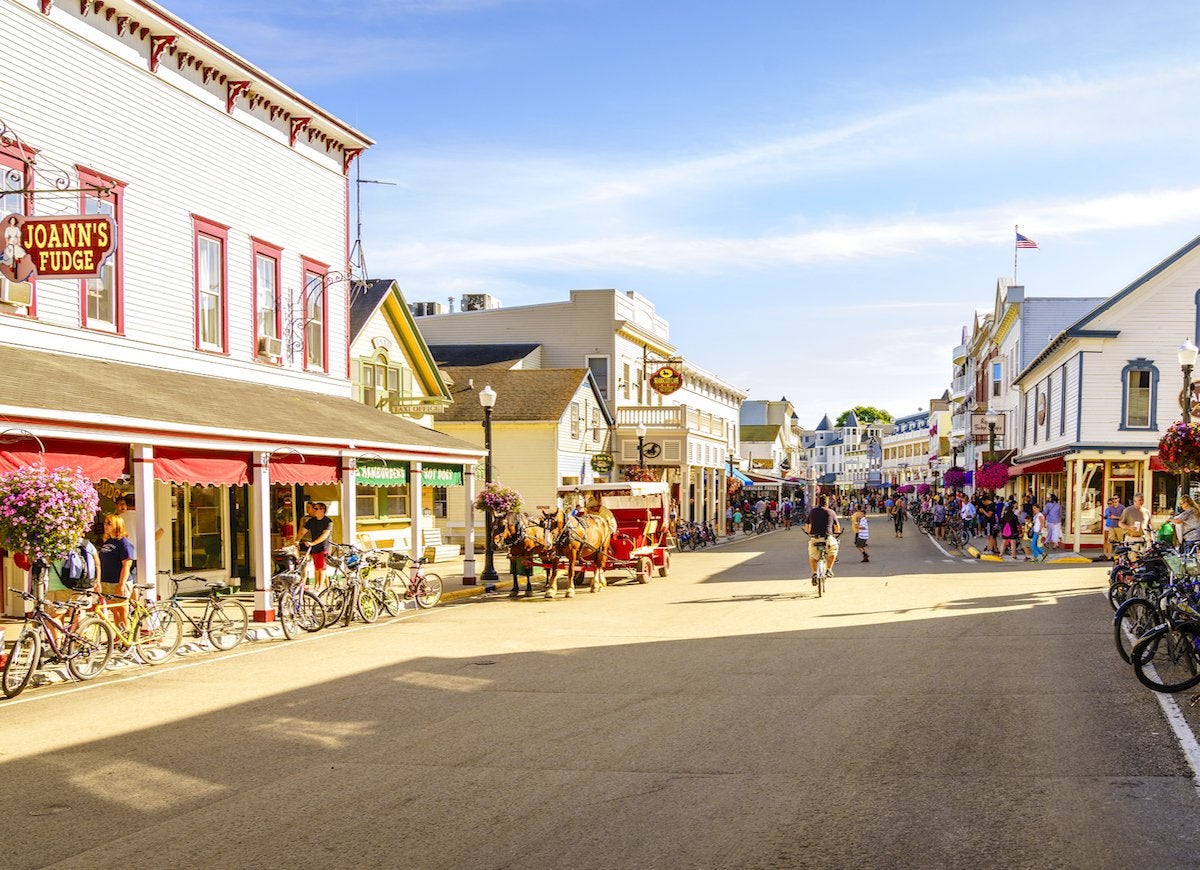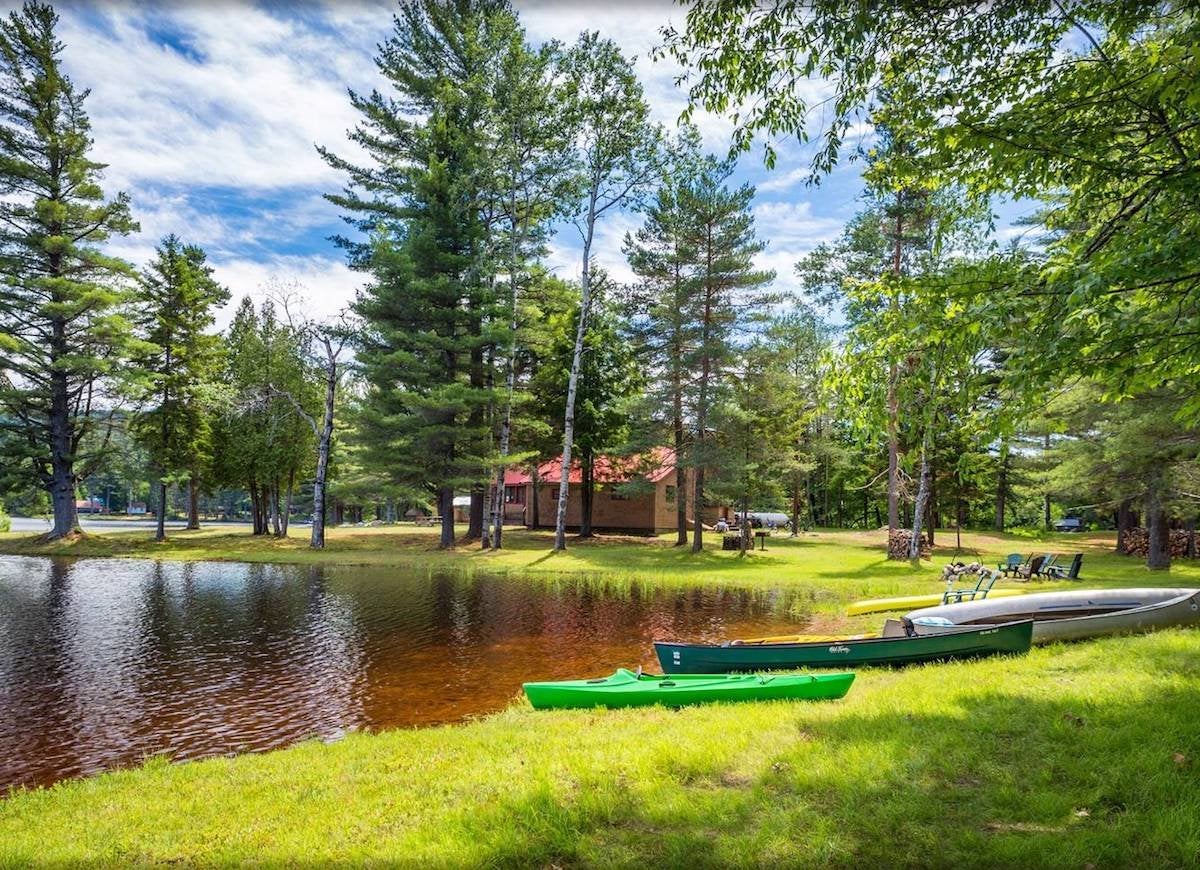We may earn revenue from the products available on this page and participate in affiliate programs. Learn More ›
Halibut Cove, Alaska

flickr.com via Andrew E. Russell
Located on the northern reaches of Alaska’s Kachemak Bay State Park, this little-known and sparsely populated island retreat is as perfect for fishing and hiking as it is for admiring art in quaint local galleries. You don’t need a car to enjoy these wonders, both natural and man-made—in fact, town transportation is limited to walking, boating, and ATVs.
Related: 10 National Parks That Look More Stunning in the Snow
Mackinac Island, Michigan

Setting foot on this island in Lake Huron is practically like going back in time to the 19th century, so abundant are the horse-drawn carriages. Add in the quaint period architecture and the natural beauty of the island, and it’s easy to see why the 3.8-square-mile community is designated a National Historic Landmark.
Related: Would You Recognize These 9 Iconic Streets Way Back When?
Monhegan, Maine

It may host the second-tallest lighthouse in Maine, but for solitude seekers, Monhegan’s biggest draw may be its car-free status. True to its name, which was derived from the Algonquian word for “out-to-sea island,” you’ll need to park your car at a port and then take a boat to reach the 69-person town.
Fire Island, New York

New Yorkers make the 15-minute ferry ride across the Great South Bay to this locale on Long Island’s south shore to escape the manic speed of life in Manhattan. Each of the 31 communities on the car-free island has its own unique draw, from the bustling bar scene of Fire Island Pines to the bayside restaurants of Ocean Beach.
Related: 15 Tiny Beach Bungalows for Your Next Vacation
Bald Head Island, North Carolina

Park your four-wheeler in nearby Southport and take a 20-minute ferry ride to this golf-cart community with 10,000 acres of nature preserves. There will be no whirring of engines or honking of horns to contend with as you hike, kayak, or snap selfies with the island’s abundant sea turtle population.
Related: 12 Destinations You Should Actually Visit During the Off-Season
Russell Island, Michigan

Zillow Digs home in Russell Island, MI
Sandwiched between Algonac and Walpole Island is this private island filled with small-town charms and big attractions, from paddling along the St. Clair River to camping at Algonac State Park. To enjoy them, however, you’ll need to ditch your car—golf carts are the only motor vehicles permitted on the island.
Tangier Island, Virginia

flickr.com via Steve Droter/Chesapeake Bay Program
You won’t stumble on this hidden gem during a road trip along the Eastern Seaboard; Tangier Island is accessible only by plane or boat. But if you’re up for a journey across the sea or sky, you’ll enjoy pristine beaches and the island’s active marine life as well as the southern comfort food of the region.
Related: You’ll Never Believe What These 6 Amazing Homes Used to Be
Supai, Arizona

A dream destination for lovers of desert scapes, Supai is so remote that mail is still delivered by mule to the 208-person community in the Grand Canyon. Because the nearest road is eight miles from town, you can rest assured that your view of Supai’s mesmerizing gorges and waterfalls won’t be impeded by automobiles.
Related: Endless Acres: 14 of the Biggest Properties in America
Phantom Ranch, Arizona

flickr.com via Felix Lew
Peace and quiet are guaranteed for the 100 nature-loving souls who dwell in this Grand Canyon National Park village that is accessible only by mule or raft, or on foot. And unlike Supai, Phantom Ranch has no official mail service.
Related: Living Remotely: 12 Stunning Homes in the Middle of Nowhere
Arcosanti, Arizona

To further his concept of “arcology,” a fusion of architecture and ecology, Italian architect Paolo Soleri conceived of and began construction on an experimental settlement that encouraged environmentally friendly living. The result is Arcosanti, a 100-person car-free town with an organic layout intended to foster a high degree of social interaction between residents while still protecting their privacy.
Catalina Island, California

But for a sprinkling of golf carts, two-seater hatchbacks, and buses, Catalina Island is car-free and proud. The eight-mile-wide island situated southwest of Los Angeles is known for its millennia-old rock formations and a Mediterranean climate that’s ideal for year-round sightseeing and sunbathing.
Beaver River, New York

The eight permanent residents of this town, not much bigger than half a square mile in all, are true adherents to a minimalist lifestyle. Beaver River is accessible by foot, boat, electric rail, snowmobile, or skis, and there is no electricity.
Related: 17 Log Cabins We Love
Isle Royale, Michigan

Travel is possible only by foot or wheelchair on Isle Royale, Lake Superior’s largest naturally formed island. It lacks both roads and permanent residents, but the town’s car-free status isn’t a point of contention with visitors, who come to enjoy hiking-friendly Isle Royale National Park.
Related: Endless Acres: 14 of the Biggest Properties in America
Governor's Island, New York

Accessible via ferries from Manhattan and Brooklyn, this island permits only the occasional car, bus, minibus, or electric golf cart, requiring visitors to get around on foot or bike instead. Few balk at the limited modes of transport because the 172-acre island is highly walkable and lined with shade trees.
Related: The Best U.S. Cities for a Summer Staycation
Rock Island, Wisconsin

flickr.com via Alyson Hurt
In contrast to many other car-free communities, Rock Island prohibits the use of both cars and bicycles, so visitors have to get around the 1.6-mile-long island on their own two feet. With neither vehicles nor a permanent population in the town, the breathtaking landscape is interrupted only by a lighthouse, a ferry pier, and colorful native flora.
Related: The 20 Best Town Mottoes from East to West
Daufuskie Island, South Carolina

Zillow Digs home in Daufuskie Island, SC
Your gateway to this paradisiacal 400-person resort community is a ferry, the only means of reaching Daufuskie Island. The eight-square-mile community in Calibogue Sound places strict restrictions on cars but permits golf carts for getting around to the local art galleries and nature preserves.
Marsh Island, Louisiana

flickr.com via C Hanchey
Unless you count the shrimp, crabs, alligators, and ducks, this car-free island and wildlife refuge in Iberia Parish has no permanent population and no cars. The lack of automobiles, however, hasn’t stopped visitors from flocking here for recreational fishing.
Branson Landing District, Branson, Missouri

flickr.com via Branson Landing
Tourists can drive to Branson in pursuit of good times at Dolly Parton’s Stampede, Mount Pleasant Winery, and Ripley’s Believe It or Not! Odditorium. But Branson Landing, a pedestrian-friendly lakefront boardwalk, is one spot where you won’t find vehicles.
Related: 20 Must-Visit Mountain Towns Across America
Venice Canal Historic District, Venice, California

In stark contrast to most of Venice, the man-made canal district is sparsely populated and free of cars. Gondolas can travel through the canals, which were designed to resemble those of Venice, Italy, and the many bridges can be traversed by foot.
Colonial Williamsburg, Williamsburg, Virginia

A living museum, Colonial Williamsburg comprises 173 acres of re-created or reconstructed buildings from the 17th, 18th, and 19th centuries. To maintain a sense of authenticity, no automobiles are allowed on the grounds during the day. But while you won’t encounter any cars on the streets, you’ll probably run into your fair share of costumed locals eager to converse with you in period accent.
Related: 10 U.S. Towns That Are Older Than America

Save Energy While Staying Cozy
Today’s energy-efficient space heaters warm individual rooms, so users needn’t heat unoccupied areas of the house. We tested the most popular space heaters on the market to find out which ones performed the best.
